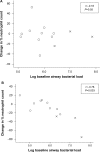Effect of levofloxacin on neutrophilic airway inflammation in stable COPD: a randomized, double-blind, placebo-controlled trial
- PMID: 24532969
- PMCID: PMC3923615
- DOI: 10.2147/COPD.S55419
Effect of levofloxacin on neutrophilic airway inflammation in stable COPD: a randomized, double-blind, placebo-controlled trial
Abstract
Rationale: Airway inflammation persists after smoking cessation in established chronic obstructive pulmonary disease (COPD), suggesting that other factors drive the airway inflammatory response.
Objectives: We tested the hypothesis that high levels of bacterial colonization are associated with increased levels of neutrophilic airway inflammation in stable COPD by examining the cross-sectional relationship between these measurements and by conducting a randomized, double-blind, placebo-controlled study of the effect of levofloxacin in patients with stable COPD.
Methods: Patients were randomized to receive either levofloxacin 500 mg daily or placebo for 7 days and underwent sputum induction for a differential cell count and quantitative bacterial analysis at baseline and at days 7, 14, and 28.
Results: Sputum percentage neutrophil count correlated with airway bacterial load at baseline (r=0.56; P=0.003). Levofloxacin reduced bacterial load compared with placebo by 4.9-fold (95% confidence interval, 1.4-25.7; P=0.02) at day 7 but had no effect at any point on any marker of neutrophilic airway inflammation. In patients with a baseline bacterial load of more than 10(6) cfu/mL, levofloxacin treatment was associated with a 26.5% (95% confidence interval, 1.8%-51.3%; P=0.04) greater reduction in the percentage neutrophil count compared with placebo at day 7. Change in percentage neutrophil count correlated significantly with baseline airway bacterial load and change in airway bacterial load.
Conclusion: In stable COPD, levofloxacin treatment causes a short-term reduction in bacterial load. This is associated with a reduction in neutrophilic airway inflammation in patients with high bacterial loads. Further studies are required to investigate whether this effect is clinically advantageous.
Keywords: antibiotics; bacteria; sputum.
Figures




References
-
- Rabe KF, Hurd S, Anzueto A, et al. Global Initiative for Chronic Obstructive Lung Disease Global strategy for the diagnosis, management, and prevention of chronic obstructive pulmonary disease: GOLD executive summary. Am J Respir Crit Care Med. 2007;176(6):532–555. - PubMed
-
- Wilkinson TM, Patel IS, Wilks M, Donaldson GC, Wedzicha JA. Airway bacterial load and FEV1 decline in patients with chronic obstructive pulmonary disease. Am J Respir Crit Care Med. 2003;167(8):1090–1095. - PubMed
Publication types
MeSH terms
Substances
Grants and funding
LinkOut - more resources
Full Text Sources
Other Literature Sources
Medical

